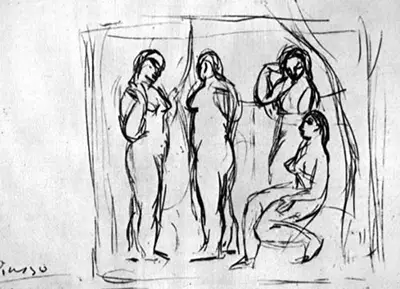Study to Girls from Avignon artwork depicts five prostitutes from the brothel on Avignon Street in Barcelona. Most people have found the characters in the painting intriguing since none of them lack a conventional lady figure. The three on the left side have facial features exhibited in Picasso’s Iberian drawing style. The other two on the right have African mask-like faces. The girls are strewn on the painting in a bewildering provocative manner. This aspect led the viewers to think it rather immoral during its first exhibition. However, it was later accepted to be one of the finest pieces of artwork ever made by the Spaniard.
The painting brings out a particular sense of racial primitivism exhibited by the mask faces. Pablo Picasso used the style to express an original artistic style bordering a strong compelling force. The Study to girls from Avignon painting deviates from the traditional European paintings to adopt a two-dimensional picture plane. This shows how the painter evolved in his talent with a spirit ever ready to embrace new ideas and styles in the field. This may have caused a stir among his audience and even close associates.
The Study of Girls of Avignon was rather controversial yet revolutionary. One of Picasso’s associates, Matisse, wasn’t pleased with the painting and regarded it as a horrible joke. Braque, another associate, was displeased too but went ahead to study this masterpiece in detail. Further collaboration between Braque and Picasso played a major role in the evolution of Cubism as a style of art.
Study to Girls from Avignon was viewed publicly for the first time in Salon d’Antin in July 1916 art exhibition. The event was organized by Andre Salmon who had referred to the painting in 1912 in one of his publications. He renamed the painting to reduce the controversies within the public domain at the time of exhibition in Paris. Today artists can only marvel at the uniqueness of styles portrayed in Picasso's paintings from the past.

